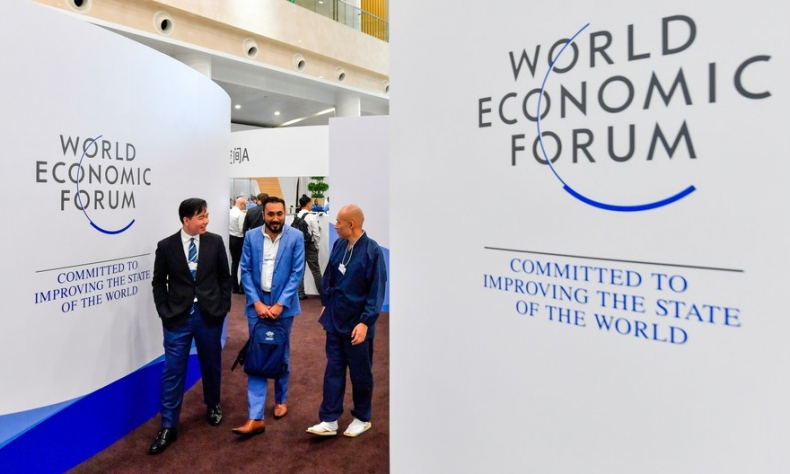Key Lessons from the Summer Davos

Decoupling based on relatively old data, or following certain narrow-minded narratives with some stemming from the Cold War 2.0 trap, entail risks of their own.
Are we bound to live in separate bubbles? Are we working with the wrong assumptions to face the present and the future? These questions alongside hot topics like artificial intelligence, biotech and the market for healthcare were addressed during the World Economic Forum’s 14th Annual Meeting of the New Champions, also known as the Summer Davos, in northern Chinese port city Tianjin in June, with Premier Li Qiang attaching great value to openness and sharing, and calling for efforts to build an open world economy.
The three-day economic summit in June, the first offline one in four years following the global pandemic, brought VIP delegates, including World Trade Organization Director-General Ngozi Okonjo-Iweala, New Zealand Prime Minister Christopher Hipkins and nearly 1,500 top public and private leaders from more than 90 countries. Premier Li adopted a technocratic approach, stressing that governments should not overreach, still less stretch the concept of risk or turn it into an ideological tool. “It is the businesses that are most sensitive and are in the best position to assess such risks,” he said. Or in other words, we should try to avoid the politicization of economic issues.
There are several things supporting the technocratic approach or down-to-earth rationality to avoid turning the world into separate bubbles. Li himself, who visited France and Germany recently, advocated in Tianjin — as he did in Paris and Berlin — the need for deeper cooperation and communication.
It is no surprise that unlike some Western governments, top businesses feel a similar need. With a number of high-profile foreign business leaders, including Microsoft’s co-founder Bill Gates, Tesla chief Elon Musk, JPMorgan Chase Chief Executive Officer Jamie Dimon and Apple CEO Tim Cook visiting China this year, it is safe to assume that they felt a similar need to get connected and cement confidence. As the China Europe International Business School’s Vice President, Frank Bournois, put it straightforwardly: “If we are going with decoupling, we would lose about 5 percent of growth worldwide.”
In recent years critical dependency on China for rare-earth metals and some pharmaceutical products have made the EU aware of its position. However, any necessary adjustment may not preclude potential cooperation. Departing EU Chamber of Commerce President Jorg Wuttke’s last advice was: “The EU must avoid overestimating the risks and underestimating the benefits of engagement.” Moving backwards looks untenable as the EU’s as well as United States’s trade with China continues to grow strongly in 2023.
Furthermore, China is faring excellently in core hi-tech development in terms of such factors as scientific publications and patents. China now dominates 37 of 44 key research fields. According to the think tank Australian Strategic Policy Institute, in the 2018-2022 period, China dominated manufacture of electric batteries (70 percent) and nanoscale materials and manufacturing (roughly 50 percent).

True, the Chinese economy is not growing at a rate as fast as in the previous decades. Having entered a new normal of development, the country now attaches importance to development quality. The central government is strongly investing in innovation, and doubling down on R&D.
The Regional Comprehensive Economic Partnership (RCEP) signals where the wind is blowing. The world’s largest free trade area, covering 2.3 billion people or 30 percent of the world’s population, contributes US $25.8 trillion or about 30 percent of the global GDP, and accounts for over a quarter of the global trade in goods and services, and 31 percent of global foreign direct investment inflows, according to the World Bank. Who is the main trading partner in this 15-member partnership? China!
It’s the same equation everywhere else. China is now the main trading partner of two-third of all countries, including in Africa, Latin America, and most of Europe and Eurasia. So, if a leader, planner or high executive thinks their company is not at “risk” and they are willing to compete and improve in the Chinese market, they should stay on, despite political considerations. Whichever cardinal point you choose to move to in the Asian neighborhood, you will meet bright minds and companies from Chinese cities like Beijing, Tianjin, Shanghai, Shenzhen, Chengdu, Guangzhou, Chongqing and Nanjing.
China has also made new progress in major scientific projects. In June China began digging its deepest borehole to study the deepest areas of Earth, aiming to penetrate more than 10 continental strata and reach the cretaceous system in Earth’s crust. The cretaceous project is part of Beijing’s efforts to explore new frontiers in space and below Earth’s surface since President Xi Jinping urged the country’s leading scientists to break new barriers in various fields in 2021, including deep Earth exploration. It will lead to new discoveries in the earth sciences and possibly new sources of energy.
Tellingly, as the Tianjin meeting concluded, the EU released the European Council’s conclusions on China, which stated that the EU “does not intend to decouple or to turn inwards” and will continue to engage with China to tackle global challenges and “encourages China to take more ambitious action” on different fields, including climate change and biodiversity. It came in the wake of The Guardian newspaper informing its readers that a new report by the American NGO Global Energy Monitor says that China is set to double its energy capacity and produce 1,200 gigawatts through wind and solar power by 2025, reaching its 2030 carbon goal five years ahead of time.
In sum, if you see the present without prejudice, China continues to be an opportunity and part of the solution for several challenges the world faces. Decoupling based on relatively old data, or following certain narrow-minded narratives with some stemming from the Cold War 2.0 trap, entail risks of their own. These are some of the main lessons from the Tianjin summit.
 Facebook
Facebook
 Twitter
Twitter
 Linkedin
Linkedin
 Google +
Google +










